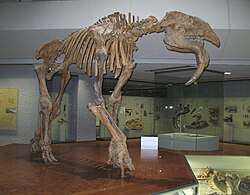Welcome to the Prehistoric Creatures and Fossils blog:)
Please rate and comment
Sunday 24 April 2011
Deinotherium
At times known as the ‘hoe tusker’, the Deinotherium was a creature that lived during the Middle Miocene era and died sometime during the Early Pleistocene era. It’s also known as being the third largest land animal to have ever existed, standing about 15 feet tall and weighing over 15.4 tons.The creature looks much like present-day elephants, the only real difference being that they had a shorter trunk and the tusks were attached to the lower jaw, not the upper jaw like today’s elephants.
It's Fossil
Deinotherium fossils have been found all over, mainly in Europe, Asia, and Africa. After these fossils were found, many believe that the large teeth and tusks were the catalysts to Greek beliefs of giant archaic creatures. The solid bone tusk could of been used to defend themselves from predators with.Just by looking at the Deinotherium, you can correctly assume that they are more than likely ancestors of the elephants you see today. The creature is also said to be related to the gomphotheres as well as the mastodons, both of which are extinct creatures.
Velociraptor
A Velociraptor was a type of dinosaur that lived during the late cretaceous and is a quite well known creature. Velociraptor were part of the family of carnivorous dinosaurs called Dromaeosauridae. This family of dinosaur had large brains and were clever enough to hunt in packs, and were fearsome predators . Velociraptors are famous and very well known for the long curved blade of a claw on the second toe of each foot. It is also well known for its clawed hands and sharp teeth but unlike other Dromaeosauridae had larger heads and longer jaws.
It's Fossil
The skeleton of the Velociraptor is small but the build of it allows the body to be stremlined making the Velociraptor a quick runner and the claw on its foot was its main weapon and the creature used it to pierce and rip through huge chunks of flesh. Also as it has a long jaw it can eat more.
Saturday 23 April 2011
Iguanodon
Iguanodon was a bulky herbivore that lived during the early cretaceous and was around 10 meters long and weighed about 3 tonnes to 3.5 tonnes on average. The Iguanodon's arms were long (up to 75% the length of the legs) and robust with rather inflexible hands built so that the three central fingers could bear weight. The thumbs were conical spikes that stuck out away from the three main fingers.They could have been used for defense, or for foraging for food.
It's Fossil
Triceratops
Triceratops was a type of dinosaur that lived in the cretaceous which is well known for its huge horns and its huge thick skull. The skull of a Triceratops is solid bone has been known to have patterns on it, and the Triceratops horns are also made of solid bone and males use them to fight with during mating seasons to impress female Triceratops and would also use them to defend themselves from predators.
Triceratops were herbivores and ate grass and small bushes and plants. Triceratops were the heaviest members of a dinosaur family called Caratopsidae and grazed in large herds throughout western North America. Triceratops were also quite hard to hunt due to there thick skulls and the thick hide that covers there bodies.
Its Fossil
The skull of the Triceratops is almost impossible to damage or break making it a great form of defence along with the solid boned horns that were great for piercing through the flesh of predators.
They also have thick strong leg bones good for running and thick spine which give good support.
Subscribe to:
Posts (Atom)









